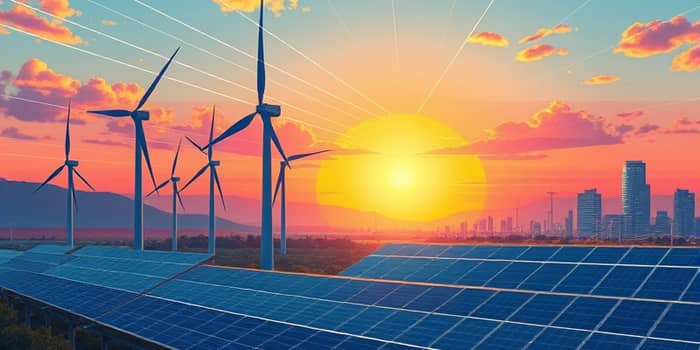As global economies accelerate toward a low-carbon future, renewable energy investment reaches unprecedented heights. In 2024, the world poured $728 billion into clean power, yet the path to net zero demands far more. This article explores the investment landscape, highlights emerging trends for 2025, and offers practical insights for investors, policymakers, and advocates seeking to bridge the gap between ambition and action.
The State of Global Investment
In recent years, renewable energy has climbed to the forefront of the transition, becoming the second-largest category of clean energy spending after electrified transport. Despite a record high investment in renewables, the annual figure falls well short of the $5.6 trillion per year needed between 2025 and 2030 to stay on track for net zero by 2050. Electrified transport spending—already at $757 billion in 2024—must quadruple to $3 trillion, while renewables and grid upgrades require a 58% boost above current levels.
The investment gap is stark, yet it underscores the immense opportunity for capital deployment. Private investors, institutional funds, and public agencies alike are called to innovate financing structures, de-risk emerging markets, and collaborate on cross-sector partnerships that can mobilize trillions in sustainable projects.
2025 Trends Driving Change
For the first time in history, renewables are projected to overtake coal as the world’s largest source of electricity, supplying roughly 35% of global power. Solar photovoltaic (PV) systems are capturing nearly half of the growth in demand, propelled by rapidly declining equipment costs and accelerated capacity expansions in key markets.
- Cleantech manufacturing is forecast to drive an extra 11 GW of demand by 2030, as factories electrify and automate.
- Data centers, powered by generative AI workloads, could jump from 26–33 GW in 2024 to 60–80 GW by 2030, intensifying competition for clean power.
- Direct air capture (DAC) installations may add 2.7 GW of load by 2030, coupling carbon removal with renewable supply.
Regional Policies and Incentives
Legislative frameworks remain a central pillar of growth. The U.S. Inflation Reduction Act has catalyzed massive deployment, yet faces political uncertainty affecting policies. In Europe, robust targets and a 2.6% drop in greenhouse gases in Q2 2024—even as GDP grew—demonstrate successful decoupling of emissions and economic expansion. Meanwhile, China’s steadfast climate commitments hint at an earlier-than-expected peak in oil demand by 2025.
Investors must stay vigilant of policy shifts: anticipated adjustments to tax credits, border carbon adjustments, and domestic content requirements can reshape project viability and return profiles across regions.
Diverse Investment Opportunities
Renewable energy spans a variety of technologies, each with unique risk-return characteristics and development timelines. Understanding these nuances enables strategic portfolio diversification and targeted capital allocation.
Economic and Social Impact
Beyond decarbonization, renewable projects generate tangible socioeconomic advantages. Investments by firms like Monarch Private Capital have creating thousands of green jobs in communities worldwide, abating 120 million metric tons of CO₂ equivalent and equaling the removal of 28 million cars from roads each year.
As clean energy costs undercut coal and natural gas in many markets, corporate procurement and utility portfolios increasingly tilt toward renewables, further reinforcing economic resilience and social welfare.
Challenges and Pathways Forward
Despite promising dynamics, significant hurdles remain. Grid networks, historically designed for centralized generation, require upgrades to handle variable output and maintain reliability. Regulatory complexities, especially around permitting and environmental approvals, can delay projects by years.
Emerging solutions—pressing need for grid resilience—include energy storage integration, smart grid investments, and AI-driven operational efficiencies. Carbon markets, domestic supply chain development, and demand from advanced industrial users will also influence returns and risk management strategies.
- Mobilizing capital at scale for transport and infrastructure electrification
- Enhancing grid flexibility through storage and demand response
- Navigating evolving policy landscapes with scenario planning
A Vision Beyond 2030
Looking ahead, the investment curve steepens dramatically. Annual clean energy investment must swell from hundreds of billions to multiple trillions within a decade. Fortunately, mature technologies, accelerating cost declines, and growing regulatory support position renewables as the cornerstone of climate and energy security.
By adopting innovative finance mechanisms, forging multi-stakeholder partnerships, and championing policies that align economic returns with environmental imperatives, investors can help shape a resilient, prosperous, and sustainable global energy system. The window for action is now—embrace the opportunity to power tomorrow with clean, reliable energy.
References
- https://about.bnef.com/energy-transition-investment/
- https://kpmg.com/xx/en/our-insights/esg/energy-transition-investment-outlook-2025-and-beyond.html
- https://www2.deloitte.com/us/en/insights/industry/renewable-energy/renewable-energy-industry-outlook.html
- https://www.ecohz.com/blog/renewable-energy-trends-2025
- https://www.monarchprivate.com/impact-investment-types/renewable-energy/
- https://byjus.com/physics/renewable-energy/
- https://about.bnef.com/new-energy-outlook/










